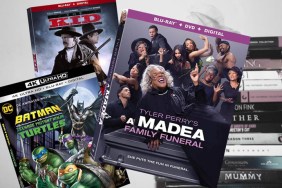Mad Hot Ballroom is a comfort food movie, something you watch on a cold, rainy day, or when your day has been metaphorically cold and gray (i.e. real life shitty) and you want nothing more than escapist entertainment that won’t insult your intelligence. A 2005 documentary that follows three different dance troupes of students from New York public schools (PS 115 in Washington Height; PS 150 in Tribeca; PS 112 in Brooklyn), it’s one of those films that almost justifies hackneyed praise by film critics: “It’s uplifting and life affirming!” “You’ll laugh, you’ll cry!” “A triumph of the human spirit!” All of that is actually true.
The film begins ten weeks out from a citywide competition in which junior high school ballroom dancers from across the city will compete for bragging rights and trophies. With over 6,000 kids from more than 60 schools participating in the ballroom dancing arts program, filmmakers Marilyn Agrelo (director) and Amy Sewell (writer) decide to follow three schools whose student bodies represent varied class, racial, and economic realities that provide the film’s rich subtext. Their prescient choices pay off many times over.
As the clock ticks toward the big competition, the camera cuts back and forth between rehearsals taking place at each school. We see kids with astonishing natural abilities, and those with very little. But the film treats them all respectfully – especially as the camera moves away from the schools and tracks some of the kids’ home lives, canvassing the neighborhoods in which they live to help flesh out their realities.
Principal Clarita Zeppie, of PS 115 notes that her primarily Dominican student body is comprised largely of single-parent households, with many kids living with grandparents, uncles, aunts, cousins, or other extended family, and there’s a 97% poverty rate. That kind of raw data backstory info nestles alongside some of the kids’ own observations about everything from educational opportunities (or lack of), drugs, crime, their changing bodies and the world’s reactions to them, and domestic strife. Most of those observations are delivered in quick conversational sketches that add gravitas without weighing the film down, reminding the viewer just how fraught childhood can be and how much real shit kids are navigating and negotiating every day. At one point, 11-year-old Emma, talking to a female classmate and facing the camera says, “Eleven year-old girls are the number one target for kidnappers. For sick people who like little girls.” Her classmate says nothing but her eyes bulge in reaction.
Still, it’s the amazing and not so amazing dancing that is the film’s point and glue. As the film unfolds, and the dance teams gel into cohesive units, the viewer is presented with powerful arguments for maintaining or reinstating arts programs in American public schools. We see the practice sessions slowly instill a work ethic in the young participants, giving them discipline and focus, turning trouble makers into dedicated students and clearing the way for outcasts (new immigrant students, those bullied for perceived queerness) to shine. The film overflows with all manner of humor (such as when one boy, in talking about the consequences of puberty notes, “You gotta start putting on deodorant. You gotta start washing two times a day. You start growing hair in weird places”).
But there’s also all manner of lump-in-the-throat moments: the young Muslim boy who says of the dance program,“I think it’s good because everyone is nice to me. They don’t care if I’m from another country;” watching the teachers become visibly moved at the progress of their students; and the close-up at the end of one of the underdog kids as he beams at the trophy he and his team have just won.







